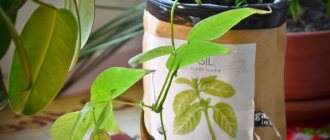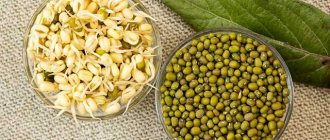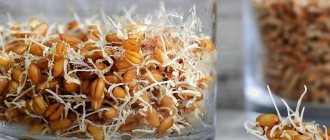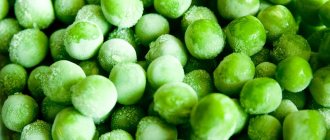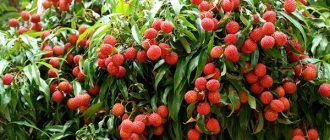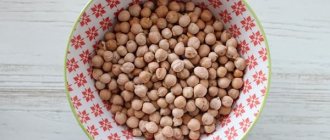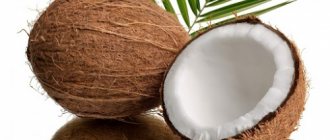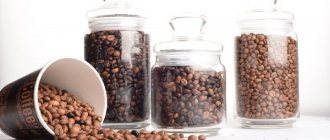Article about germinating different seeds on the website PP Delicious! Already there, I would like to dwell separately on how to germinate mung beans and why do it at all. Mash is a real find for anyone who cares about their health and adheres to proper nutrition, as well as for raw foodists, vegetarians and those simply losing weight. This legume, unusual for our cuisine, is very tasty and healthy, and when sprouted, its beneficial properties increase significantly.
Mash: what is this anyway?
Mung beans (Indian beans, mung beans) are an annual plant of the legume family. Previously, it was classified as a bean genus, but then it turned out that mung bean is far from being a bean, although its green beans do look like small beans.
The approximate length of the beans is 0.3-0.6 cm. The territorial homeland of these beans is India, but mung beans are no longer uncommon in Russia.
Dry mung bean can be purchased at any grocery store, supermarket, market or ordered online. But sprouted ones can only be found on the shelves of specialized stores, so sprouting mung beans at home for food is much easier and cheaper than looking for them in stores.
Harm and contraindications
If consumed in excess or incorrectly, mung bean can cause harm to the body. It is prohibited to use in the following cases:
- Diseases in the acute phase. Pancreatitis, gastritis, ulcers, ailments of the gastrointestinal tract.
- Diseases caused by excess fiber. Pathologies in both chronic and acute phases.
- Undergoing therapy. For any treatment, mung bean is introduced into the diet only after consultation with a specialist.
- Individual intolerance. Allergies to organic matter are not uncommon, so the product is introduced gradually.
You can grow mung beans at home. When adding to the diet, it is better to take into account the daily intake of no more than three tablespoons. The product should not be used by people with reduced intestinal motility. If consumed in excess, it can cause flatulence and dyspepsia.
All about the benefits of these beans for the food industry
For any person, mung beans have many benefits :
- with regular use, the cardiovascular system is strengthened, blood pressure returns to normal, cholesterol levels in the blood decrease, sugar decreases, and the elasticity of the walls of blood vessels increases;
- mung bean has mild diuretic properties, helps relieve swelling;
- prevents the formation of cancer cells;
- has a beneficial effect on the skin;
- recommended for those suffering from asthma and allergies;
- Beans also speed up the healing of burns.
And the foodie will definitely appreciate the following qualities of mung beans:
- the variety that mung bean brings to the diet;
- ease of use;
- a large amount of protein in the composition - 23 g per 100 g of dry beans;
- promote weight loss.
The secret of this therapeutic effect lies in the composition of mung bean, because it contains useful amino acids, vitamins, as well as micro and macroelements.
Why sprouted mung bean
In its usual (dry) form, mung bean is usually used in different ways for pp recipes - as a side dish, a base for first courses, etc. Sprouted recipes have no less, but the benefits are many times greater!
During germination, the beneficial properties of mung bean are not only preserved, but also increase, and not by some percentage, but on average 3 times! And the number of calories, on the contrary, decreases. Here is a comparison of the KBZHU of dry and sprouted mung bean:
- 100 g dry mung bean - 300 kcal/23.5 g protein/2 g fat/46 g carbohydrates
- 100 g of sprouted mung bean - 255 kcal , of which 39.1 g are carbohydrates, but I did not find exact information about how much fat and protein. It is only known that the digestibility of protein in sprouted beans increases by 30%!
You can often find information online that the calorie content of sprouted mung bean is 30 kcal. This is not true! This is the calorie content of the sprouts themselves - those little “antennae”. The total calorie content is much higher!
Mung bean sprouts strengthen the immune system, improve memory, stimulate mental activity, restore vision, and help prevent infectious and inflammatory diseases. They also normalize female hormonal levels and kidney function. In addition, sprouted mung bean is considered one of the most delicious legumes.
By the way, thanks to Wikipedia, I learned that mung bean, or rather starch from these beans, is the main component of funchosa. For some reason I always thought that “glass” vermicelli was made from rice.
Chemical composition
Mung bean contains valuable vegetable protein, fiber, vitamins, minerals, protease inhibitors, and phytoestrogens, which can fully replace meat.
Sprouted beans provide the greatest value for humans, since the concentration of nutrients in them increases by 1.5 - 5 times.
Table No. 1 “Nutritional value of mung beans”
| Components | Content, g per 100 g of product [3] |
| Carbohydrates | 46 |
| Starch and dextrins | 42,4 |
| Squirrels | 23,5 |
| Water | 14 |
| Alimentary fiber | 11,1 |
| Mono- and disaccharides | 3,6 |
| Ash | 3,5 |
| Fats | 2 |
Table No. 2 “Chemical composition of mung beans”
| Name | Nutrient content, mg per 100 g of product |
| Vitamins | |
| Phylloquinone (K) | 0,009 |
| Ascorbic acid (C) | 4,8 |
| Pantothenic acid (B5) | 1,91 |
| Thiamine (B1) | 0,621 |
| Tocopherol (E) | 0,51 |
| Pyridoxine (B6) | 0,382 |
| Riboflavin (B2) | 0,233 |
| Niacin (B3) | 2,3 |
| Folic acid (B9) | 0,625 |
| Macronutrients | |
| Potassium | 1000 |
| Phosphorus | 358 |
| Magnesium | 174 |
| Calcium | 192 |
| Sodium | 40 |
| Microelements | |
| Iron | 6 |
| Zinc | 2,68 |
| Manganese | 1,035 |
The calorie content of mung beans and their sprouts is 300 and 30 kcal, respectively.
The best ways to germinate mung beans
There are several different ways to germinate mung beans:
- Soaking in water - you can use both special equipment and ordinary dishes.
- Using boiling water.
- Germination in a jar.
Classic version
This method is the most popular, one might say traditional.
It's quite simple:
- prepare the beans - rinse the mung bean with running water;
- soak (dip the mung bean in water) - the beans will absorb liquid, so you need the water to cover it by 1-2 centimeters. It is recommended to use distilled or filtered water. The soaking process lasts a minimum of 8 and a maximum of 12 hours;
- rinse - after soaking, drain the water from under the beans and rinse them. Under the right conditions (high humidity and warm air temperature), small seedlings can already be seen after soaking;
- germinate - washed mung bean needs a lot of oxygen, for this we place it on a tray or wide dish. The mung bean should remain slightly moist, make sure it does not dry out. It takes 8 to 12 hours to saturate the seedlings with oxygen. To speed up the process, the beans can be stirred, thereby adding air flow. It is better to keep mung beans in a dark and warm place. The warmer and more humid it is in the room in which mung beans are sprouted, the faster the seedlings will appear.
Seedlings no more than a centimeter long will bring maximum benefit. If you want to slow down germination, put the beans in the refrigerator.
Boiling water is not scary for sprouts
Surprisingly, you can only use boiled water for germination! Boiling water will speed up the process.
- We sort through the mung bean, discarding debris and dry beans, then rinse it in running water and place it in a sprouter (preferably in one layer);
- Boil 125 ml of water and pour 70 g of beans into it. Boiling water will not only not harm the seedlings, but will also destroy all pathogenic microflora. We place the dishes with mung bean in a dark, warm and windproof place;
- After 8-9 hours, the beans will absorb water, after which you need to add more water so that the sprouts are completely covered. During the day you need to make sure that the beans do not dry out, but it is also not recommended to pour them too much. Periodically, these peas must be washed in cool running water;
- After about 30 hours, the length of the sprouts will be from 0.3 to 0.5 cm. The sprouts will be ready for consumption after 96 hours, during this time it is necessary to occasionally moisten them and stir them;
- Now all that remains is to rinse the beans and remove the green shells.
How to germinate mung beans in a jar
The method of germination in a jar is very convenient:
- rinse the required amount in running water, then soak directly in the jar in water at room temperature in a ratio of 1:4 and leave overnight;
- In the morning, the mung beans must be thoroughly rinsed and drained. (it is convenient to use a lid with holes);
- Pour water at room temperature into the jar of mung bean so that the water slightly covers the beans;
- Once every 6-8 hours we rinse the mung beans with running water;
- already on the third day, some seeds will begin to shed their green shell, and on the fifth day they will be ready for use.
Secrets of storing sprouts
Store-bought dry beans can be stored throughout their expiration date without opening the package. If the package is opened, put it in the refrigerator. It is not recommended to store mung bean packaging near heating devices - due to increased temperature and humidity, the beans may rot. After buying beans at the market, be sure to sort them, removing any wrinkled or damaged seeds.
Sprouts cannot be stored for longer than two days, and before use they should be rinsed in running water.
How to use
Despite the many beneficial properties of mung bean, you should ideally consult a doctor before consuming it, especially if you have digestive problems or suspected allergies. Well, or try just a little bit. Also, beans should not be consumed by children under 5 years of age. It is important not to exceed the daily intake - 60 g of beans or 3 tablespoons.
Sprouted mung bean is ready for consumption and does not require additional processing, so it can be used in a wide variety of ways:
- Use fresh. Mung bean sprouts are very tasty and resemble green peas. When mung bean is consumed without additional ingredients, its digestibility increases.
- In the salad. Mung bean sprouts go well with many ingredients and are suitable for any green salad. You can cook, for example, these.
- In the form of a vegetable stew . If possible, add sprouts at the very end of cooking to preserve their beneficial properties as much as possible;
- In the form of a smoothie or fresh juice .
- As a base for cutlets - ideal for vegetarians.
Mikhail My name is Mikhail, I am 41 years old. By vocation and education I am a cook, I often cook for the whole family. But I work in a completely different field. I love to cook, I know how. This is probably why I ended up among the authors of the site. In addition, I have been a vegetarian for several years now, and often experiment, adapting a variety of recipes to my tastes. I hope my experience will be useful to readers of the site.
Recipes
Sprouted mung bean cutlets
Grind 1 cup of sprouts and 70 g of pre-boiled rice in a blender. Fry cumin, coriander and asafoetida, 1 teaspoon each, for 1-2 minutes in a frying pan, add 1 grated carrot to them and simmer for another 5 minutes. Combine the mixture of sprouts and rice with spices. The minced meat is ready. Add salt to taste, form cutlets and fry in a pan or steam.
Hearty smoothie
500 ml of water, a large handful of spinach, celery or parsley, 2 bananas, 2 tablespoons of mung bean sprouts, 5 dates add to a blender and blend.
Korean usage
In Korea, lightly boiled (less than 1 minute) mung sprouts are often served as a separate dish. Then cool and mix with sesame oil, garlic, salt, and other ingredients.
For lovers of hot and spicy Korean salad recipe:
Ingredients:
- 3 tablespoons of sprouts;
- 1 medium onion;
- 2 cloves of garlic;
- 1 teaspoon sesame seeds (white or black, preferably black and white);
- 1/3 teaspoon of monosodium glutamate (optional), a pinch of granulated sugar, hot pepper to taste, jalapeno (depend on your taste), if you don’t have fresh hot pepper, take coarsely ground chili, 2 peas of freshly crushed black pepper.
Preparation:
- Lightly rinse the mung bean sprouts and place in boiling water. After boiling, cook for 1 minute, then drain the water and drain the sprouts in a colander.
- At the same time, throw the black and white sesame seeds into a pre-heated frying pan and fry a little until the white sesame seeds are browned.
- Quickly discard the seeds into the prepared plate to prevent them from overcooking.
- Chop the onion as finely as possible and pour boiling water over it for 10-15 seconds. Chop the garlic.
- Combine onions, garlic, sesame seeds, cooled sprouts and add spices. Mix everything thoroughly and pour in hot, preferably sesame, oil and mix again.
- Before eating, let the salad sit for 15-20 minutes.
